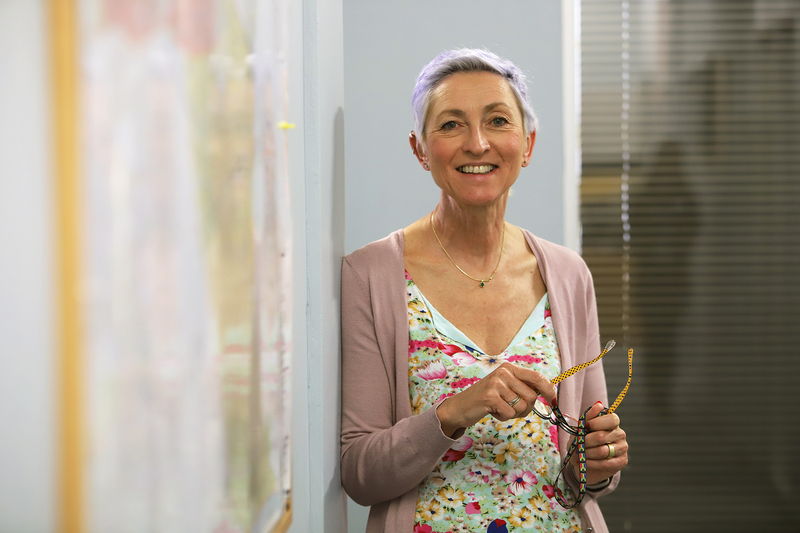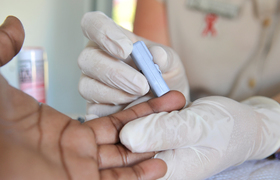SA a world leader in HIV research
04 December 2019 | Story Nadia Krige. Photo Michael Hammond. Read time 9 min.
A new report charting global trends in HIV/AIDS research has identified South Africa as one of the global leaders in the field. The University of Cape Town (UCT) was also revealed to be the most influential institution, based on its global field-weighted citation impact.
Released late last week in the run-up to World AIDS Day on Friday, 1 December, the Elsevier Report offers a comprehensive overview of the HIV/AIDS research landscape. Titled HIV/AIDS research insights: impacts, trends, opportunities, it is divided into three sections: the global impact of HIV, research progression and trends, and countries and institutions leading the charge.
Data in the report comes from Elsevier’s SciVal and Scopus databases. The analysis covers research published between 2014 and 2018.
With 35 493 publications related to HIV/AIDS between 2014 and 2018, the United States (US) is by far the top producer of research in the field. This surpasses the second-highest contributor, the United Kingdom (UK), by more than 27 000 publications.
Showing its dedicated response to HIV/AIDS as an ongoing national health crisis, South Africa follows the US and the UK as the third biggest producer of relevant research in the field. According to the report, South Africa produced close to 7 000 publications between 2014 and 2018.
“This is an extraordinary achievement, given we’re a small country,” said Professor Linda-Gail Bekker, deputy director of the Desmond Tutu HIV Centre (DTHC) at UCT’s Institute of Infectious Disease and Molecular Medicine (IDM).
“For us it’s the coming together of burden of disease, a good critical mass of expertise and then obviously infrastructure that lends itself to getting this kind of research done.”
UCT making its mark
While institutions with the highest HIV/AIDS research output are predominantly located in the US – correlating with the top research-producing countries – UCT and the University of the Witwatersrand (Wits) were also named among the top ten, taking 8th and 9th positions respectively.
Looking at field-weighted citation impact (FWCI), however, UCT tops the global list with an FWCI of 3.8 and 1 873 publications between 2014 and 2018.
“This is an extraordinary achievement, given we’re a small country.”
FWCI is an article-level metric that takes the form of a ratio: actual citations for a given research output divided by the expected citation rate for outputs of similar age, subject and publication type. UCT’s FWCI of 3.8 suggests that its HIV/AIDS research output is seen to be highly influential.
“I have no doubt that the IDM has made an enormous contribution to that set of papers,” Bekker said.
Apart from the DTHC, the IDM is home to a number of research groupings focusing on various aspects of HIV/AIDS and HIV/tuberculosis (TB) co-infection. Among others, there is the Wellcome Centre for Infectious Diseases Research in Africa (CIDRI-Africa) and the South African Tuberculosis Vaccine Initiative (SATVI).
“HIV-related research in the IDM is wide-ranging. In addition to the internationally renowned research programmes on the prevention and management of HIV/AIDS and the evolution and pathogenesis of HIV, researchers in, and associated with, the IDM also lead major programmes on the prevention and management of HIV-associated tuberculosis and TB-immune reconstitution inflammatory syndrome (TB-IRIS), HIV-associated fungal opportunistic infections, and mucosal immunity in the female and male reproductive tracts,” said Valerie Mizrahi, director of the IDM.
“They and others across the faculty and university have applied their enormous talent, passion and energy to tackling one of the defining health challenges of our time. As IDM director, I am very proud of UCT’s standing as a global leader in HIV research.”
UCT’s work on HIV also extends beyond the IDM, with research in a diverse set of groups in the Faculty of Health Sciences looking at, for example, the relationship between HIV and non-communicable diseases such as mental health, and the epidemiology of HIV in population groups, with further research in other faculties examining social and economic aspects of HIV. This broad range of work assists with translation.
SA’s translational approach
Embroidering on this, Bekker explained that one of the strengths in South Africa’s HIV/AIDS research output is the fact that it has been able to take a lot of the work being done in laboratories out into the field and back into the labs again for further refinement.
“My gut feel is that South Africa has contributed a lot on the implementation side of things, the actual clinical aspects, because for us it really is bread and butter translational research on a daily basis,” she said.
“It hasn’t just been funding and walk away. It really has been an exchange of ideas and skills.”
Bekker also believes that South Africa still has an enormous contribution to make simply because of the country’s burden of disease.
As incidence of infection has begun to disappear in parts of the world, it’s getting harder to run efficacy trials to test new modalities of vaccines and treatment. While bittersweet – though nevertheless the truth – South Africa is still in the position to run this kind of pragmatic research.
“We’re absolutely at the centre of all the big prevention trials at the moment. We also continue to contribute to a lot of the strategy treatment trials: Should you use this drug versus that drug? What happens if you use this combination of treatment?
“I think our skill set really continues to position us very much in the international front runners. So, I think this trend is likely to continue for a long time actually.”
The power of collaboration
One of the report’s most interesting findings is the fact that international collaboration is a main feature of research coming from the top institutions.
“[O]f the top ten institutions that produce the most research on HIV/AIDS, more than half of the output involves international collaboration,” the report reads.
UCT and Wits also presented the highest percentage of collaboration, with approximately 74% involving international collaborators.
“We have a very high index of collaboration, particularly with northern institutions,” Bekker said.
“It might be that, post-1994, our relationship with the international community has grown stronger. Also, a lot of our funding for this kind of work comes from the north.”
She highlights that even though funding may have been a big driving force for collaborations, the relationships with overseas institutions have been anything but one-sided.
“We’ve been able to export a lot of our understanding and lessons learned to the [developed] world, and I think that relationship has been meaningful,” she said.
“It hasn’t just been funding and walk away. It really has been an exchange of ideas and skills.”
Bekker, however, believes that as we move into the latter part of the three-decade fight against HIV/AIDS, we’ll be witness to much more South–South collaboration.
“I think increasingly – particularly with multi-centre trials – the countries to the north of us in sub-Saharan Africa are becoming stronger partners than perhaps in the very early part of this journey.”
Three eras of HIV/AIDS research
Since the virus first started having a global impact in the early 1980s, Bekker believes that there have been three distinct eras of HIV/AIDS research.
First there was description and recognition, followed by the Lazarus effect of anti-retroviral treatment (ARVs), which brings us to the moment we find ourselves in today: the revolution of prevention, as Bekker calls it.
She explained that instead of just being dependent on the ABC [abstinence, be faithful and condomise] of HIV prevention, researchers are now beginning to look at ways in which ARVs can be repurposed as prevention.
“We’ve moved into the era now of post- and pre-exposure prophylaxis, and I think South Africa is making a huge contribution there again,” she said.
“So, it’s been nice that there have been these three eras that we have very much participated in all along.”
 This work is licensed under a Creative Commons Attribution-NoDerivatives 4.0 International License.
This work is licensed under a Creative Commons Attribution-NoDerivatives 4.0 International License.
Please view the republishing articles page for more information.










